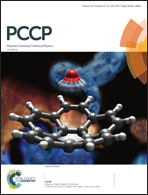A theoretical study on anion sensing mechanism of multi-phosphonium triarylboranes: intramolecular charge transfer and configurational changes†
Abstract
The binding selectivity and recognition mechanism of a series of mono-, di- and triphosphonium substituted triarylboranes: (4-(dimesitylboryl)-3,5-dimethylphenyl)phosphonium ([Mes2BArP]+, 1), 1,1′-mesitylboranediylbis(3,5-dimethylphenyl)phosphonium ([MesBArP2]2+, 2) and 1,1′,1′′-boranetriyltris(3,5-dimethylphenyl)phosphonium ([BArP3]3+, 3) where ArP = 4-(H3P)-2,6-Me2-C6H2, for various anions has been investigated by employing density functional theory (DFT) and time dependent-density functional theory (TD-DFT) methods. Natural population analysis indicates the electrophilic nature of the boron centers in 1-3 for the nucleophilic addition of anions. The calculated free energy changes (ΔG) reveal that out of CN−, F−, Cl−, Br−, NO3−, CH3COO− and HSO4− only the binding of CN− and F− with 1, 2 and 3 is thermodynamically feasible. In addition, the calculated binding energies reflect that CN− shows lesser binding affinity than F− with 1, 2 and 3. Frontier molecular orbital (FMO) analysis reveals that the first excited states (S1) of 1–3 are the local excited states with a π → π* transition, whereas the third excited state (S3), fifth excited state (S5), fourth excited state (S4) and fourth excited states (S4) of [Mes2BArP]+F (1F, the fluoro form of 1), [MesBArP2]2+F (2F, the fluoro form of 2), [Mes2BArP]+CN (1CN, the cyano form of 1) and [MesBArP2]2+CN (2CN, the cyano form of 2), respectively, are charge separation states found to be responsible for the intramolecular charge transfer (ICT) process. The partial configuration changes and ICT induce fluorescence quenching in 1F, 2F, 1CN and 2CN synergistically after an internal conversion (IC) from their respective S3, S5, S4 and S4 to S1.



 Please wait while we load your content...
Please wait while we load your content...